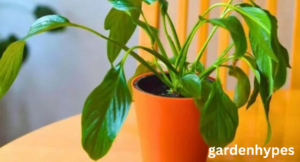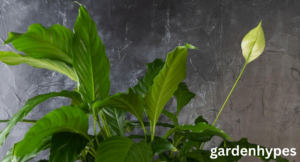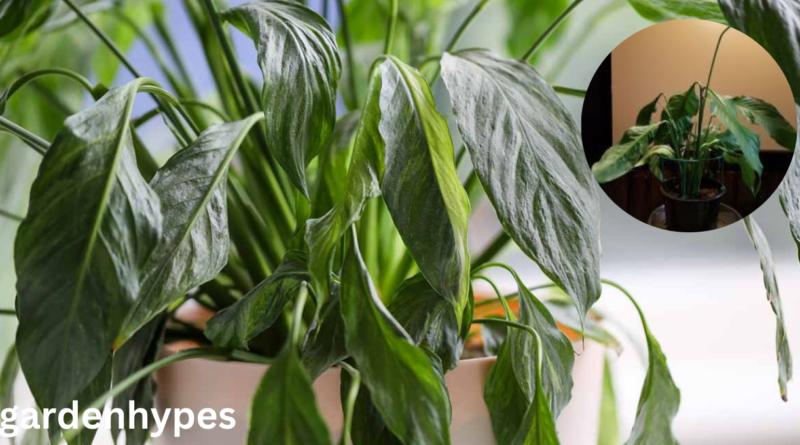Overwatered Peace Lily Causes Symptoms & Solutions
Introduction to Peace Lilies
Overwatered Peace Lily are among the most loved indoor plants around the world. Their deep green leaves and elegant white blooms give homes and offices a refreshing and calming look. Apart from their beauty, peace lilies are also excellent air purifiers, making them one of the best choices for indoor gardening beginners. However, as easy as they are to care for, peace lilies often suffer from a very common mistake—overwatering.
click in link Outdooe Potted Plants
Many plant owners assume that giving extra water means giving extra love, but for peace lilies, this is not true. These plants naturally thrive in tropical environments where the soil drains quickly, and while they enjoy moisture, they don’t like sitting in soggy soil. To keep a peace lily healthy, it’s important to understand its basic needs. They require medium to low light, occasional feeding, and just the right amount of water to keep their roots strong.
Unfortunately, too much water can drown the roots, leading to yellow leaves, drooping stems, and eventually plant death if not corrected. Understanding how to spot the early signs of overwatering and knowing how to fix it can make all the difference between a thriving plant and one that struggles to survive.
In this article, we’ll explore how to identify an overwatered peace lily, the common causes behind it, and the best ways to save and prevent this problem in the future.
Understanding the Problem of Overwatering
Overwatering is the number one killer of peace lilies. Unlike some hardy plants that can survive poor care, peace lilies are particularly sensitive to waterlogged soil. This problem usually happens when owners water the plant too often, not realizing that peace lilies prefer a balance of moisture and dryness in the soil.
In their natural rainforest environment, peace lilies grow under the shade of taller trees. They receive indirect light and moisture from rain, but the soil drains quickly, preventing the roots from staying wet for too long. When grown indoors in pots, this balance can be difficult to maintain.
Overwatering essentially drowns the roots, depriving them of oxygen. Roots need both air and water to function properly. When the soil remains constantly wet, the oxygen supply is cut off, causing roots to suffocate and rot. Once root rot sets in, the plant struggles to take up nutrients and water, leading to visible signs of stress above the soil.
Many people mistakenly think a drooping peace lily needs more water, but sometimes, it’s the opposite—the plant is already drowning. Understanding this difference is key to keeping your peace lily alive and thriving.
Signs of an Overwatered Peace Lily
Yellowing Leaves
One of the earliest and most obvious signs of overwatering is yellow leaves. When roots are damaged by excess water, they cannot properly deliver nutrients to the leaves. As a result, the lush green color fades to yellow. Unlike underwatering, which causes leaves to turn dry and crispy, overwatered leaves remain soft and limp.
Drooping and Wilting
Peace lilies are known for their “dramatic” droop when thirsty, but drooping can also happen due to too much water. The difference is in how the plant reacts afterward. A thirsty plant perks back up after watering, but an overwatered one continues to wilt no matter how much water it receives.
Root Rot
Perhaps the most dangerous symptom is root rot. If you pull the plant out of the pot and see mushy, black, or brown roots instead of firm, white ones, your peace lily is suffering from root rot. This condition spreads quickly and can kill the plant if not treated immediately.

Foul Odor from Soil
Another sign of overwatering is a musty or rotten smell coming from the soil. This odor indicates bacterial or fungal growth caused by waterlogged conditions. Healthy soil should smell earthy, not sour or unpleasant.
click in link Outdooe Potted Plants
Recognizing these signs early gives you a better chance to save your peace lily before the damage becomes irreversible.
Causes of Overwatering
Watering Too Frequently
The most common reason peace lilies get overwatered is frequent watering. Many plant owners follow a fixed schedule instead of checking the soil’s actual moisture. Watering every few days without testing the soil leads to excess water buildup.
Poor Soil Drainage
Soil that retains too much water is another major culprit. Regular garden soil or heavy mixes trap moisture, suffocating the roots. Peace lilies need a well-draining mix that allows extra water to escape easily.
Wrong Pot Size or Lack of Drainage Holes
If the pot is too big for the plant, it holds more soil, which retains water for longer. Likewise, pots without drainage holes trap water at the bottom, creating a swamp-like environment around the roots.
Seasonal Watering Mistakes
Peace lilies need less water in winter when growth slows down. Many owners fail to adjust watering during colder months, leading to soggy soil and root problems.
Each of these causes contributes to the same outcome—an unhealthy, struggling peace lily. By identifying and fixing the specific cause in your case, you can bring your plant back to health.
How to Revive an Overwatered Peace Lily
Saving an overwatered peace lily is possible if you act quickly. The recovery process involves examining the plant, treating root damage, and creating a better watering routine.
Checking the Roots
The first step is to gently remove the plant from its pot. Examine the roots closely—healthy roots are firm and white, while rotting ones are mushy and brown. Trim away the rotten sections with clean scissors to prevent the spread of infection.
Repotting the Plant
After trimming, repot your peace lily in fresh, well-draining soil. Choose a pot with drainage holes to ensure excess water can escape. Avoid using soil that feels heavy or compact.
Adjusting the Watering Schedule
Water only when the top inch of soil feels dry to the touch. Stick your finger in the soil—if it feels moist, wait before watering again. This method prevents accidental overwatering.
click in link Outdooe Potted Plants

Improving Soil Drainage
Mixing perlite, sand, or orchid bark into the soil can improve drainage. This allows the roots to breathe and reduces the risk of waterlogging.
Reviving an overwatered peace lily takes patience. It may take weeks or even months for the plant to recover fully, but with proper care, it will slowly regain its lush green beauty.
faqs
1. How long does it take for an overwatered peace lily to recover?
The recovery time depends on how badly the plant has been affected. If caught early, your peace lily may start showing signs of improvement within a week or two after adjusting its care routine. However, if root rot has set in, it could take several weeks or even months for the plant to fully bounce back. The key is patience—trim off damaged roots and leaves, repot in fresh soil, and stick to a proper watering schedule.
2. Should I cut off yellow leaves from my peace lily?
Yes, it’s a good idea to remove yellow or dying leaves. They won’t turn green again, and leaving them on the plant can waste its energy. Use clean scissors to cut the yellow leaves at the base of the stem. This not only helps the plant look healthier but also encourages new growth.
3. Can peace lilies survive root rot?
Yes, they can survive root rot if you act quickly. The trick is to remove the plant from its pot, trim away all the mushy, dark roots, and replant it in well-draining soil. If most of the roots are healthy, your plant stands a good chance of survival. But if root rot has spread too far, it may be difficult to save the plant.
4. How do I know if my peace lily needs water?
The easiest way is the finger test—stick your finger about an inch into the soil. If it feels dry, it’s time to water. Another natural sign is drooping leaves; peace lilies dramatically droop when they’re thirsty but quickly perk back up after a drink. Just make sure you don’t confuse this with overwatering droop, where the plant doesn’t recover after watering.
5. What type of pot is best for peace lilies?
Peace lilies grow best in pots with proper drainage holes. A pot that’s just slightly bigger than the plant is ideal, because oversized pots hold too much soil, which retains excess water. Terracotta pots are great because they allow moisture to evaporate, reducing the risk of soggy soil.
